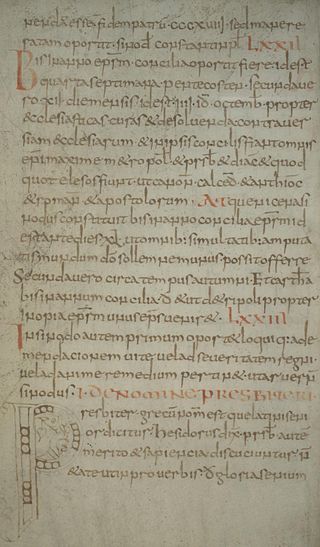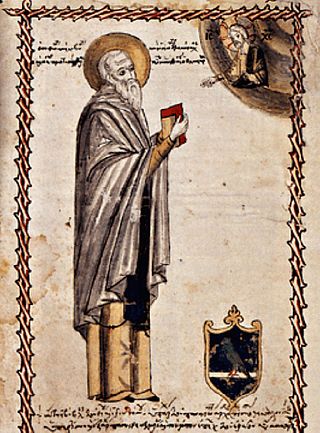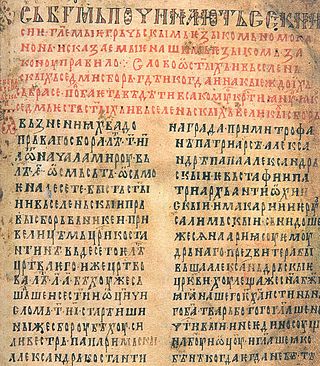
Dušan's Code is a compilation of several legal systems that was enacted by Stefan Uroš IV Dušan of Serbia in 1349. It drew upon Roman law, Byzantine law, as well as elements of customary and canon law. It was used in the Serbian Empire and the succeeding Serbian Despotate. It is considered an early constitution, or close to it; an advanced set of laws which regulated all aspects of life such as family relations, property rights, contracts, and crimes.
An ecclesiastical province is one of the basic forms of jurisdiction in Christian Churches with traditional hierarchical structure, including Western Christianity and Eastern Christianity. In general, an ecclesiastical province consists of several dioceses, one of them being the archdiocese, headed by a metropolitan bishop or archbishop who has ecclesiastical jurisdiction over all other bishops of the province.

The Apostolic Canons, also called Apostolic canons, Ecclesiastical Canons of the Same Holy Apostles, or Canons of the Holy Apostles, is a 4th-century Syrian Christian text. It is an Ancient Church Order, a collection of ancient ecclesiastical canons concerning the government and discipline of the Early Christian Church, allegedly written by the Apostles. This text is an appendix to the eighth book of the Apostolic Constitutions. Like the other Ancient Church Orders, the Apostolic Canons uses a pseudepigraphic form.

Byzantine law was essentially a continuation of Roman law with increased Orthodox Christian and Hellenistic influence. Most sources define Byzantine law as the Roman legal traditions starting after the reign of Justinian I in the 6th century and ending with the Fall of Constantinople in the 15th century. Although future Byzantine codes and constitutions derived largely from Justinian's Corpus Juris Civilis, their main objectives were idealistic and ceremonial rather than practical. Following Hellenistic and Near-Eastern political systems, legislations were tools to idealize and display the sacred role and responsibility of the emperor as the holy monarch chosen by God and the incarnation of law "nómos émpsychos", thus having philosophical and religious purposes that idealized perfect Byzantine kingship.
The canon law of the Catholic Church is "how the Church organizes and governs herself". It is the system of laws and ecclesiastical legal principles made and enforced by the hierarchical authorities of the Catholic Church to regulate its external organization and government and to order and direct the activities of Catholics toward the mission of the Church. It was the first modern Western legal system and is the oldest continuously functioning legal system in the West, while the unique traditions of Eastern Catholic canon law govern the 23 Eastern Catholic particular churches sui iuris.

The Collectio canonum Hibernensis is a systematic Latin collection of Continental canon law, scriptural and patristic excerpts, and Irish synodal and penitential decrees. Hib is thought to have been compiled by two Irish scholars working in the late 7th or 8th century, Cú Chuimne of Iona and Ruben of Dairinis.
Theodore Balsamon, also called Balsamo, was a canonist of the Eastern Orthodox Church and 12th-century Eastern Orthodox Patriarch of Antioch.
A nomocanon is a collection of ecclesiastical law, consisting of the elements from both the civil law and the canon law. Nomocanons form part of the canon law of the Eastern Catholic Churches and of the Eastern Orthodox Church.

Matthew Blastares was a 14th-century Byzantine Greek monk in Thessalonica and early scholarly opponent of reconciliation with Rome. He was also the writer of the Syntagma Canonum.
Collections of ancient canons contain collected bodies of canon law that originated in various documents, such as papal and synodal decisions, and that can be designated by the generic term of canons.

The Zakonopravilo, was the highest code in the Serbian Orthodox Church. It was finished in 1219. This legal act was written in simple language. Its basic purpose was to organize the continuation and functioning of the Serbian Kingdom and the Serbian Church. It was originally printed under the name Rules of Speech in Serbian at Raška, Serbia, in two successive issues, one for Wallachia and another for Transylvania. It is Serbia's first Serbian-language church-state constitution.
Jus antiquum is a period in the legal history of the Catholic Church, spanning from the beginning of the church to the Decretum of Gratian, i.e. from A.D. 33 to around 1150. In the first 10 centuries of the church, there was a great proliferation of canonical collections, mostly assembled by private individuals and not by church authority as such.
The Catholic Church utilizes the oldest continuously functioning legal system in the West, much later than Roman law but predating the evolution of modern European civil law traditions. The history of Latin canon law can be divided into four periods: the jus antiquum, the jus novum, the jus novissimum and the Code of Canon Law. In relation to the Code, history can be divided into the jus vetus and the jus novum. Eastern canon law developed separately.
The Law of Serbia comprises many levels of codified and uncodified forms of law, of which the most important is the Serbian Constitution.

The Collectio canonum Quesnelliana is a vast collection of canonical and doctrinal documents prepared (probably) in Rome sometime between 494 and (probably) 610. It was first identified by Pierre Pithou and first edited by Pasquier Quesnel in 1675, whence it takes its modern name. The standard edition used today is that prepared by Girolamo and Pietro Ballerini in 1757.

In canon law, a canon designates some law promulgated by a synod, an ecumenical council, or an individual bishop.
The Eastern Catholic canon law is the law of the 23 Catholic sui juris (autonomous) particular churches of the Eastern Catholic tradition. Eastern Catholic canon law includes both the common tradition among all Eastern Catholic Churches, now chiefly contained in the Code of Canons of the Eastern Churches, as well as the particular law proper to each individual sui juris particular Eastern Catholic Church. Oriental canon law is distinguished from Latin canon law, which developed along a separate line in the remnants of the Western Roman Empire, and is now chiefly codified in the 1983 Code of Canon Law.

Serbian medieval law spans a period of time from the first half of the 7th century AD to the second half of the 15th century AD. While the origins of the Serbian medieval law can be traced back to folk customs and beliefs, the forms of written law started to appear owing to Serbian emperors, kings and archbishops of that era. It is through their charters and various codes that punishments were introduced and status, civil, criminal and procedural law started developing. Serbian medieval law was visibly influenced by the Byzantine law whose impact was profound.
Gabriel of Baṣra was a bishop and jurist of the Church of the East.
The canon law of the Eastern Orthodox Church consists of the ecclesiastical regulations recognised by the authorities of the Eastern Orthodox Church, together with the discipline, study, and practice of Eastern Orthodox jurisprudence.







